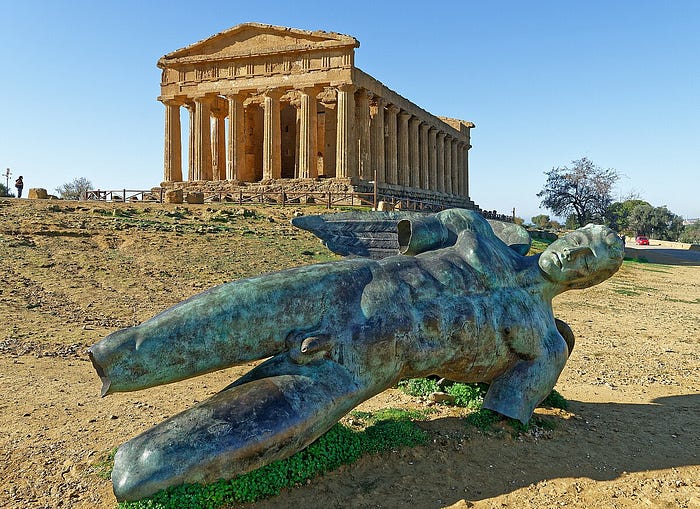Exploring the Ancient Wonders of Agrigento, Sicily's Temples
Written on
Chapter 1: The Legacy of the Ancient Greeks
The ancient Greeks have bequeathed us numerous remarkable structures, with some of the most stunning located in Agrigento, previously referred to as Akragas. Here, visitors can behold magnificent examples of Doric architecture, particularly within the renowned Valley of the Temples, or Valle dei Templi. Below, we explore the key attractions of this archaeological marvel.
Valle dei Templi serves as a significant archaeological park in Agrigento, situated in southern Sicily. It showcases extraordinary architectural remnants from Greater Hellas, with the ancient city of Akragas spanning approximately 1800 hectares. Recognized for its immense cultural and historical importance, the "Archaeological Area of Agrigento" was added to the UNESCO World Heritage List in 1997.
Section 1.1: Historical Background of the Valley
The earliest signs of Greek presence in southern Sicily trace back to the 14th century BCE. Archaeologists have uncovered artifacts, including ceramics and tholos tombs, indicating habitation by Mycenaean people.
The establishment of Akragas occurred in 582 BCE, founded by settlers from Gela alongside colonists from Rhodes and Corinth. The city's name originates from the river that lined its banks.
Within a century, Akragas emerged as one of the most influential Greek colonies. Its peak occurred under the tyrants Phalaris and Theron. Theron notably triumphed over the Carthaginians at the Battle of Himera in 480 BCE and initiated the city's expansion and infrastructure modernization.

Akragas extended its territory from Mount Etna to Himera, reaching Selinunte and Gela. The city thrived economically through the export of leather, olive oil, and wine, fortified by defensive walls stretching approximately 12 km with nine gates. Its interior housed splendid temples, administrative structures, and residential areas.
Following Theron's death in 473 BCE, his son Thrasydaeus briefly took power. However, in 471 BCE, the citizens revolted and established a democratic system, guided by philosopher Empedocles.
The city fell to the Carthaginians in 406 BCE but was rebuilt in 350 BCE under Timoleon's leadership, only to suffer again during the Punic Wars. By 210 BCE, it was under Carthaginian control.
During the Second Punic War, the Romans captured Akragas, renaming it Agrigentum. The reconstructed temples were dedicated to Roman deities.
As the Roman Empire declined, Agrigentum faced barbarian invasions and later Byzantine control. In 828 CE, Arabs occupied the area, renaming it Kerkent. The Normans conquered Sicily in 1087 CE, calling the city Girgenti until Mussolini restored its name to Agrigento in 1927.
Chapter 2: The Temples of the Valley
In this video, we delve into the stunning ancient architecture of Agrigento, showcasing the Valley of the Temples and its rich historical significance.
The majority of monuments within the Valley of the Temples have not weathered time well. This deterioration results from the city's tumultuous history and natural disasters, particularly earthquakes.
One notable structure is the Bouleuterion, built around the 4th to 3rd centuries BCE as a meeting place for the city council. It featured a rectangular design resembling an amphitheater.
Another fascinating site is the ruins of the Gymnasium, constructed during Roman times, along with archaic necropolises carved into the ancient city walls during the Byzantine era. The early Christian catacombs, known as Grotta Fragapane, are also significant remnants.
One of the park's most enigmatic attractions is the Mausoleum of Theron, intended as the tyrant's tomb. Some scholars suggest it dates to Roman times, honoring those who perished in the First Punic War.
Key Attractions in the Valley
The Valley of the Temples is renowned for its splendid remnants of Hellenistic and Roman architecture, exemplifying the Doric style and the expertise of ancient architects.
Temple of Jupiter (Zeus Olympios):
This temple was among the largest religious edifices of the ancient world, constructed to commemorate the victory over the Carthaginians in 480 BCE. Measuring 56 meters wide and 113 meters long, only fragments of its foundations remain today.
Temple of the Dioscuri (Castor and Pollux):
Only the circular altar and a corner with four columns, reconstructed in 1836, are left of this once-magnificent temple.
Temple of Concordia:
The best-preserved Greek temple in the valley, built in 430 BCE, measures approximately 42 meters long and 20 meters wide. Its clay foundation absorbed seismic shocks, helping it withstand the ravages of time. It was converted into a Christian basilica in 597 CE, further preserving its integrity.
Temple of Hephaestus:
Constructed in the latter half of the 5th century BCE, only two columns remain.
Temple of Hercules:
Erected in the 6th century BCE, this is the oldest temple in the Valley. Surviving elements include the pronaos and opisthodomos, originally adorned with 38 Doric columns.
Temple of Juno (Hera):
Built between 450 and 440 BCE, this is the second-best preserved temple, with thirty columns still standing.
Trivia About the Valley of the Temples
Here are some intriguing facts about the Valley of the Temples:
- In antiquity, the east symbolized life and light, leading to the orientation of temples towards the east.
- A museum near the archaeological site showcases valuable artifacts and was once a Cistercian monastery.
- Cities in Magna Graecia enjoyed independence from the Greek polis.
- Phalaris, Akragas's first tyrant, is notorious for inventing the bronze bull, a cruel torture device.
- The Valley is adorned with almond trees, whose pink blossoms create a stunning backdrop for the ancient ruins.
In this captivating video, explore the spectacular Greek Valley of Temples in Agrigento, Sicily, and learn about its historical significance and architectural brilliance.
Attention all readers!